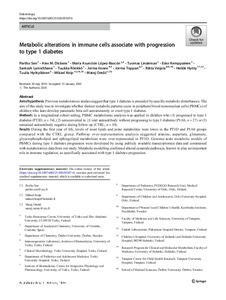Metabolic alterations in immune cells associate with progression to type 1 diabetes
Partho Sen; Alex M. Dickens; María Asunción López-Bascón; Tuomas Lindeman; Esko Kemppainen; Santosh Lamichhane; Tuukka Rönkkö; Jorma Ilonen; Jorma Toppari; Riitta Veijola; Heikki Hyöty; Tuulia Hyötyläinen; Mikael Knip; Matej Orešič
https://urn.fi/URN:NBN:fi-fe2021042826018
Tiivistelmä
Aims/hypothesis
Previous metabolomics studies suggest that type 1 diabetes is preceded by specific metabolic disturbances. The aim of this study was to investigate whether distinct metabolic patterns occur in peripheral blood mononuclear cells (PBMCs) of children who later develop pancreatic beta cell autoimmunity or overt type 1 diabetes.
Methods
In a longitudinal cohort setting, PBMC metabolomic analysis was applied in children who (1) progressed to type 1 diabetes (PT1D, n = 34), (2) seroconverted to ≥1 islet autoantibody without progressing to type 1 diabetes (P1Ab, n = 27) or (3) remained autoantibody negative during follow-up (CTRL, n = 10).
Results
During the first year of life, levels of most lipids and polar metabolites were lower in the PT1D and P1Ab groups compared with the CTRL group. Pathway over-representation analysis suggested alanine, aspartate, glutamate, glycerophospholipid and sphingolipid metabolism were over-represented in PT1D. Genome-scale metabolic models of PBMCs during type 1 diabetes progression were developed by using publicly available transcriptomics data and constrained with metabolomics data from our study. Metabolic modelling confirmed altered ceramide pathways, known to play an important role in immune regulation, as specifically associated with type 1 diabetes progression.
Conclusions/interpretation
Our data suggest that systemic dysregulation of lipid metabolism, as observed in plasma, may impact the metabolism and function of immune cells during progression to overt type 1 diabetes.
Kokoelmat
- Rinnakkaistallenteet [27094]
